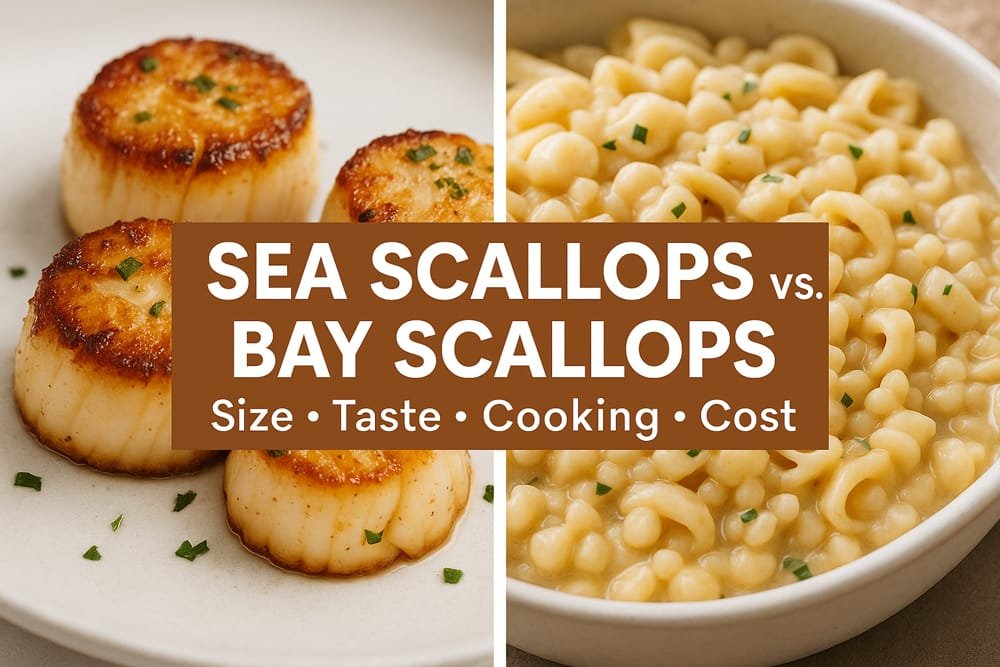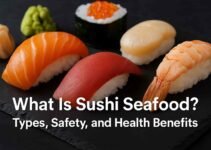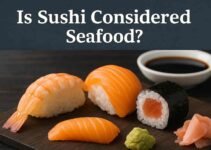Scallops are a seafood delicacy enjoyed around the world, but not all scallops are the same. Among the most common types found in markets and on restaurant menus are sea scallops and bay scallops. Though they may look similar to the untrained eye, they differ significantly in size, texture, flavor, cooking applications, and even price.
Understanding the difference between sea scallops and bay scallops is essential for both home cooks and professional chefs. Choosing the right type can elevate a recipe, enhance the dining experience, and even affect sustainability decisions. In this guide, we’ll break down the key distinctions between these two popular mollusks to help you make informed choices in the kitchen.
Contents
What Are Scallops?
Scallops are marine bivalve mollusks, meaning they have two hinged shells, similar to clams and oysters. However, unlike many other bivalves, the edible portion of a scallop is the adductor muscle—the part that opens and closes its shell. This muscle is prized for its delicate flavor and slightly sweet, tender texture.
There are over 300 species of scallops globally, but only a handful are commercially harvested for consumption. In the United States, the most commonly sold varieties are sea scallops and bay scallops. Both are members of the Pectinidae family, but they inhabit different marine environments and offer unique culinary characteristics. Understanding these differences begins with a closer look at each type individually.
What Are Sea Scallops?
Sea scallops (Placopecten magellanicus) are large, deep-sea mollusks typically found in the cold, open waters of the North Atlantic Ocean. These scallops are much bigger than their bay counterparts, often reaching up to 2 inches in diameter. Their larger size and firm texture make them ideal for searing, grilling, and other high-heat cooking methods.
They are usually harvested year-round, either by dredging or by hand via divers. Diver-harvested scallops are considered more sustainable and tend to have less grit, but they also command a higher price. Sea scallops have a mildly sweet, briny flavor and a dense, meaty bite, making them a favorite in upscale seafood dishes like pan-seared scallops with lemon butter or scallop risotto.
In terms of nutrition, sea scallops are a lean source of high-quality protein, low in fat, and rich in essential minerals such as selenium, phosphorus, and vitamin B12. Their versatility and premium taste make them a popular choice among chefs and seafood lovers alike.
What Are Bay Scallops?
Bay scallops (Argopecten irradians) are smaller, tender scallops typically found in the shallow coastal waters and estuaries along the Atlantic coast and Gulf of Mexico. Measuring about ½ inch in diameter, they are noticeably smaller than sea scallops, but what they lack in size, they make up for in sweetness and delicacy.
Bay scallops are usually harvested seasonally, with peak availability during the colder months—especially from November through March in the northeastern United States. Their soft, tender texture and sweet flavor make them ideal for dishes that require quick cooking, such as stir-fries, sautés, seafood pastas, and chowders. Due to their size, they cook rapidly and can become rubbery if overcooked, so gentle handling is essential.
Because bay scallops are more delicate, they are often more affordable than sea scallops, though prices can vary depending on seasonality and sourcing. Their natural sweetness and lightness make them a favorite in lighter dishes and appetizers where subtle seafood flavors are desired.
Side-by-Side Comparison Table
Below is a quick-reference table highlighting the main differences between sea scallops and bay scallops. This summary can help you decide which type is best suited for your recipe or dining preference.
| Feature | Sea Scallops | Bay Scallops |
|---|---|---|
| Size | Larger (up to 2 inches in diameter) | Smaller (about ½ inch diameter) |
| Texture | Firm and meaty | Soft and tender |
| Flavor | Mildly sweet, briny | Sweeter, more delicate |
| Cooking Methods | Ideal for searing, grilling | Best for sautéing, baking, chowders |
| Availability | Available year-round | Seasonal (mostly winter) |
| Price | Generally more expensive | Often more affordable |
Taste & Texture Differences
Taste and texture are two of the most noticeable ways to distinguish sea scallops from bay scallops. Sea scallops have a firmer, denser bite and a more subtle, briny flavor that pairs well with bold sauces and high-heat cooking techniques like searing. Their texture allows them to form a beautifully caramelized crust without falling apart, making them ideal for center-of-the-plate presentations.
In contrast, bay scallops are significantly more tender and offer a naturally sweeter taste. Their soft flesh responds best to gentle heat, which preserves their sweetness and prevents them from becoming chewy. Because of their size and delicacy, bay scallops are often featured in lighter dishes where their sweetness can shine, such as seafood pasta, light soups, or baked gratins.
Ultimately, the best scallop for your dish depends on the role you want the scallop to play—whether it’s a rich and hearty main course or a light, flavorful complement to a more complex plate.
Cooking Methods & Recipes
The differences in size and texture between sea scallops and bay scallops make each better suited to specific cooking techniques. Sea scallops, with their firm and meaty texture, are ideal for high-heat methods such as pan-searing, grilling, or broiling. These methods help form a golden crust on the outside while keeping the interior tender and juicy. A classic preparation involves pan-searing sea scallops in butter or oil, then finishing with a splash of lemon juice, white wine, or a delicate sauce like garlic herb butter. They also pair well with risottos, purees, and roasted vegetables.
Bay scallops, being more delicate and smaller in size, are best suited for gentle and fast cooking. Their natural sweetness makes them a perfect addition to seafood pasta, creamy chowders, and baked seafood casseroles. A quick sauté with olive oil, garlic, and parsley is often enough to highlight their flavor. Overcooking is a common mistake with bay scallops; they only need a couple of minutes of heat to reach perfection.
When planning recipes, consider the desired outcome. If you’re aiming for a dramatic presentation and a satisfying main course, sea scallops are your go-to. For lighter meals or recipes that involve multiple ingredients, bay scallops may be the better fit.
Price & Availability
One of the practical differences between sea and bay scallops lies in their cost and accessibility. Sea scallops are typically more expensive, largely due to their larger size, year-round availability, and the harvesting methods involved—especially when diver-caught, which is more sustainable but labor-intensive. They are more commonly found in fine dining restaurants and high-end seafood markets.
Bay scallops, on the other hand, are often more affordable, especially when sourced during peak season. However, availability can be limited depending on geographic location and the time of year. In the U.S., the most desirable bay scallops—such as those from Nantucket—are available only during a brief winter window and may be priced comparably to sea scallops due to their short supply.
For everyday home cooking, frozen scallops are widely available in both varieties, though quality varies significantly by brand and processing method. Look for “dry-packed” scallops, which are untreated with preservatives and retain better texture and flavor when cooked.
Sustainability & Sourcing
Sustainability has become an increasingly important consideration for seafood consumers. Fortunately, both sea and bay scallops are generally considered sustainable choices when sourced responsibly.
Sea scallops are predominantly harvested off the northeastern coast of the United States and Canada. Many of these fisheries are well-managed and certified by organizations such as the Marine Stewardship Council (MSC). Diver-harvested sea scallops are particularly sustainable as they minimize damage to the ocean floor and reduce bycatch.
Bay scallops, depending on their region, may be wild-caught or farmed. Farming, when done in open water with minimal feed and intervention, can be an environmentally friendly option. However, overfishing and habitat degradation in certain coastal areas have impacted bay scallop populations in the past. It’s important to check labels or ask your fishmonger about the origin of the scallops and whether they come from a certified sustainable source.
Consumers should also look for terms like “dry” scallops, which are free of chemical additives, and avoid “wet” scallops, which are treated with phosphates that cause them to retain excess water and lose flavor during cooking.
Which One Should You Choose?
Choosing between sea scallops and bay scallops depends on your culinary goals, taste preferences, budget, and seasonal availability.
If you’re preparing a main course that features scallops prominently—such as seared scallops with a rich sauce or a seafood risotto—sea scallops are the better choice. Their large size, firm texture, and elegant appearance make them perfect for presentation and high-heat cooking techniques. They also hold their shape well, making them ideal for grilling or skewering.
On the other hand, if you’re planning a light dish, seafood medley, or need scallops that cook quickly and blend well with other ingredients, bay scallops are likely the better fit. Their sweetness and tender texture shine in chowders, baked casseroles, and pasta dishes. They are also more budget-friendly, especially when feeding a crowd.
Ultimately, both types offer exceptional flavor and versatility. For best results, let the recipe and the occasion guide your choice.
Frequently Asked Questions
Q1: Are sea scallops better than bay scallops?
Not necessarily—each has its strengths. Sea scallops are ideal for main dishes and searing, while bay scallops excel in lighter meals and dishes with quick cooking times.
Q2: Can you substitute bay scallops for sea scallops in recipes?
Yes, but you’ll need to adjust the cooking time. Bay scallops cook faster and may not deliver the same texture or appearance in recipes that rely on the size and firmness of sea scallops.
Q3: Why are sea scallops more expensive?
Sea scallops are larger, harvested in deeper waters, and often require more labor-intensive methods like diving. These factors contribute to their higher price.
Q4: Can both types of scallops be eaten raw?
Technically, yes—if they are sashimi-grade and handled properly. However, it’s crucial to source them from trusted vendors and ensure they’ve been kept at safe temperatures.
Q5: How should I store scallops at home?
Keep scallops refrigerated and consume them within 1–2 days of purchase. For longer storage, freeze them in an airtight container. Always thaw them in the refrigerator, not at room temperature.
Conclusion
While sea scallops and bay scallops come from the same family, their differences in size, flavor, texture, and cooking applications make each one uniquely suited to different culinary roles. Sea scallops bring bold flavor and a substantial presence to the plate, while bay scallops offer delicate sweetness and versatility in lighter dishes.
Whether you’re crafting a luxurious seafood entrée or whipping up a comforting bowl of scallop chowder, knowing which type of scallop to use will elevate your dish. Whichever you choose, be sure to source your scallops sustainably and cook them with care for the best flavor and texture.
For more on scallops and seafood selection, you might enjoy:
- How to Choose Sashimi-Grade Seafood
- [Can You Eat Scallops Raw?]



